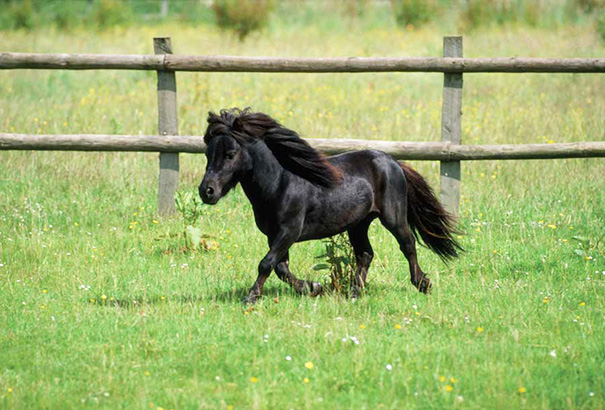
Because miniature horses are descendants of the hardy ponies of the Shetland islands, they are remarkably easy-keepers and can metabolize food very efficiently. Unlike large horses, miniature horses may eat tree leaves, bark, and other non-traditional food items. Because of their super-efficient metabolism, miniature horses are prone to obesity. If your miniature horse suffers from obesity, removing sweet-feed and grain may help, but there are cases of miniature horses who become morbidly obese while eating only hay. Also, veterinarians say that few miniature horses require high-calorie hays such as alfalfa. For such ponies, special low-feed muzzles have been developed to allow them to only consume a few strands of hay at a time.
Caring For an Elderly Miniature Horse
Due to their longevity, miniature horses suffer from a variety of geriatric issues unique to tiny ponies.
Geriatric Teeth Issues
Because miniature horses commonly live far beyond the ordinary lifespan of a larger horse (30-45 years), there are special issues relating to the care of elderly ponies. The most common issue is loss of teeth. After age 30, many miniature horses stop growing replacement teeth and choking may occur. Such horses can live happily on wet beet pulp and equine senior feed, but veterinarians say that they should be restricted from hay, carrots and any other foods that require chewing.
Geriatric Joint Issues
Just like people the elderly horse may suffer from arthritis. If the pony is still mobile and not in severe pain, periodic shots of Adaquin from your veterinarian can greatly increase mobility and reduce painful joint swelling.
Underweight
Dwarf horses and miniature horses with teeth problems will sometimes have trouble extracting calories from their feed. In these cases, isolating the miniature horse with ad-libitum high nutrition feeds will help to ensure a healthy weight.
Founder
Founder is an especially onerous issue for elderly miniature horses. Founder is especially prevalent in the spring among miniature horses with free access to pastures. Rapid changes to feeding habits precipitate founder, and the careful miniature horse owner will be careful to gradually introduce changes to diet. This includes changing types of hay. When introducing a new hay, it should be mixed-in with the existing hay supply. If your horse does founder, immediate farrier and vet care is essential because severe founder can lead to death. Founder is characterized by rapid hoof growth, and some miniature horse owners have been successful in preventing lameness with very frequent, corrective hoof trimming.
The Original Miniature Horse
The Falabella has been bred on the Falabella ranch in Argentina for over 150 years and the Falabella story began in 1845 when an Irish man named Patrick Newtall discovered that the tribes of pampas Indians had some unusually small horses. Newtall managed to obtain a quantity of falabellas and by 1853 he had created a herd of small, perfectly built little horses around 40 inches tall. In 1879 he transferred his herd and knowledge to his son-in-law, Juan Falabella. Juan continued the experiment by using other breeds to develop this small horse. He bred to the smallest English thoroughbreds he could find, Shetland ponies and Criollo, the Argentine horse of the pampas. In 1905 the herd was transferred to the next generation Emillio and in 1927 the establishment was inherited by Julio Cesar Falabella who kept careful genealogical records, introduced the blood of several other breeds including the North American Appaloosa which gave the breed it’s spotting capability and the Hackney.
Sometime after this he began to sell a few Falabellas to selected clients and the late John F. Kennedy was one of the first people to acquire some. The Falabella is linked to the earliest modern horses in the New World. The Spanish brought over Andalusian horses when they attempted to conquer the Americas, which were forced to fend for themselves when the would-be conquerors were forced to flee. To survive they had to undergo structural changes to cope with the variable climate of the pampas. Cold winds, strong sun and fierce storms are common. The land is arid, and horses must travel long distances to find pasture and water. The Falabella is gentle and docile around people but retains plenty of fizz around its herd-mates, indulging in horseplay. They are long-lived and hardy, coping very well with cold weather although most of them do appreciate some protection from prolonged spells of rain.
Creatures Corner Fun Facts
Unlike other horse breeds, the Falabella has seventeen vertebrae instead of eighteen, and one less pair of ribs.
The Falabella’s heart is slightly larger in proportion to its body when compared to the standard-size horse.
George Washington owned the first donkeys born in the United States.
Donkeys can live from 25 to 35 years of age.
Related Articles & Free Email Newsletter Sign Up
How Horse Body Language Indicates Their Mood and Potential Behavior
How Horses Sleep and Why it’s Important That They Do
The Akhal Teke Horse is One of the Most Unique Breeds in the World


Comment here